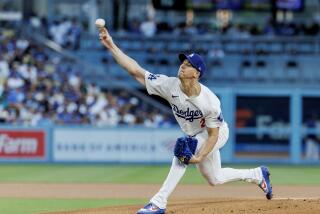With New Kidney, Hearn Is Out of Baseball, but Not Life
- Share via
He has the ring. He has the photographs, the memories and a .263 career average. And he has a second-hand kidney, a sense of humor and a measure of hope that had all but disappeared. These days, Ed Hearn concerns himself with what he has, rather than with what he’s lost.
Even at night, when he’s connected to those machines, when the apparatus cleansing his blood and providing oxygen make him look like “some freakazoid,” he’s certain this is better than what might have been. “Here I lay. But it beats the alternative,” he said.
Six years removed from the New York Mets’ glorious 1986 summer, 5 1/2 years since the trade that brought David Cone to the Mets, three years removed from his 171st and final major-league at-bat with the Kansas City Royals and two years removed from his final Triple-A fling with the Cleveland Indians, Hearn is on a comeback that, if completely successful, will leave him significantly short of resuming a career as a major-league catcher. Still, he’s quite pleased with that prospect.
Sunday, seven days shy of his 32nd birthday, he is 110 days removed from kidney transplant surgery.
“The way I look at things has changed,” he said. “I’ve had some ... I guess you could call them tough breaks. But I’m alive. And I’ve had some good luck, too. (My wife) supported me and said it can get better. Finally, I’m seeing those days. It’s a long ways from Shea Stadium, I guess, but ... “
Hearn’s words are liberally littered with “buts” and “howevers.” Few things are as good as they seemed; few are as bad. Hearn is a man who, three months ago, was too weak to stand in the shower. So understandably, he said, “Don’t call me complaining when you don’t get any hits for a couple of nights in a row. Don’t tell me your problems.”
He has enough of his own, and not only the kidney transplant. He also developed a disorder, possibly related to his kidney failure, identified as sleep apnea. Without a machine that pumps oxygen through his nose and into his lungs, he wouldn’t breathe normally during sleep. “The muscles that control my airway when I go to sleep would just relax to a point where my airway collapses and cuts off my air supply,” he said last week from his home near Kansas City.
“So for now, I sleep with this Darth Vader-looking machine. Anyone ever breaks into my house at night, I’d probably scare the hell out of them.
“It’s dejecting to look in the mirror at myself and see a professional athlete lying here with one tube coming out of his side for dialysis and this mask on his face at night and a new kidney. But it can get better.”
Hearn, the Mets’ primary understudy for Gary Carter in 1986, lives with his wife, Patricia, in Kansas City. He hopes to return full-time to his new career in insurance and is armed with an “it can get better” outlook that he said is different from his playing days. Not all that different, though. After all, he once was the guy the Mets leaned on in the minor leagues. Then, he was “Ward,” called that because of the Ward Cleaver counsel he afforded the younger players. “My wife has been my ‘Ward,’ ” he said.
Hearn learned of his kidney disorder while in high school. “They told me back then, there may come a time when my kidneys may require some treatment -- dialysis or transplant,” he said. “But at that point in my life, I just figured it would come when I got old ... I never really considered the possibility of that time coming when I was 31.
“In the fall, I found out about the sleep apnea and exactly how bad the kidneys were. We figured I’d have to go through something for the kidneys within a year. But it came on quicker than I thought, and by February, I was in need of dialysis very shortly.”
His fortunes turned by the final week of April, when the Kansas City hospital where he was receiving treatment made a kidney available to him. “If I didn’t get it then, I could’ve waited another year,” Hearn said.
But the surgery -- one kidney was transplanted, but his two non-functional kidneys were not removed -- wasn’t the end of his suffering. “It took me two months to really get to where I was feeling worth anything at all,” he said. “I’m starting to finally feel like I’ve come back to real life, I guess. I’ve been working out a little bit, starting to get back to work on a part-time basis.”
Hearn said he felt “depleted” two months ago. “I had one month straight of fever. I lost about 25 pounds. I was so tired I’d literally sleep, get up and go sit in a recliner, then go back and sleep. That was all I could do. I felt like I was a 75- or 80-year-old man. You start thinking, ‘Wow! Why did all these things happen to me?’ I’d like to catch a break here along the way.
“I guess my baseball career helped me a little with this. My minor-league career was tainted with injuries, and then I had the major injury (shoulder) with Kansas City that basically ended my career. Those situations both have helped me and caused it to be more difficult. It prepared me to handle adversity and come back from physical injuries and setbacks.”
There was a time in early 1987 when Hearn’s primary concern was overcoming the shoulder injury that became evident shortly after he was traded to the Royals for Cone. “They still talk about it here on the radio shows,” he said. “I don’t even think about it now. I hope David does great. I’ll be remembered for something. I know the Royals still think about it. They thought I was damaged goods when I got here. They must really think I’m damaged now.”
More to Read
Go beyond the scoreboard
Get the latest on L.A.'s teams in the daily Sports Report newsletter.
You may occasionally receive promotional content from the Los Angeles Times.










